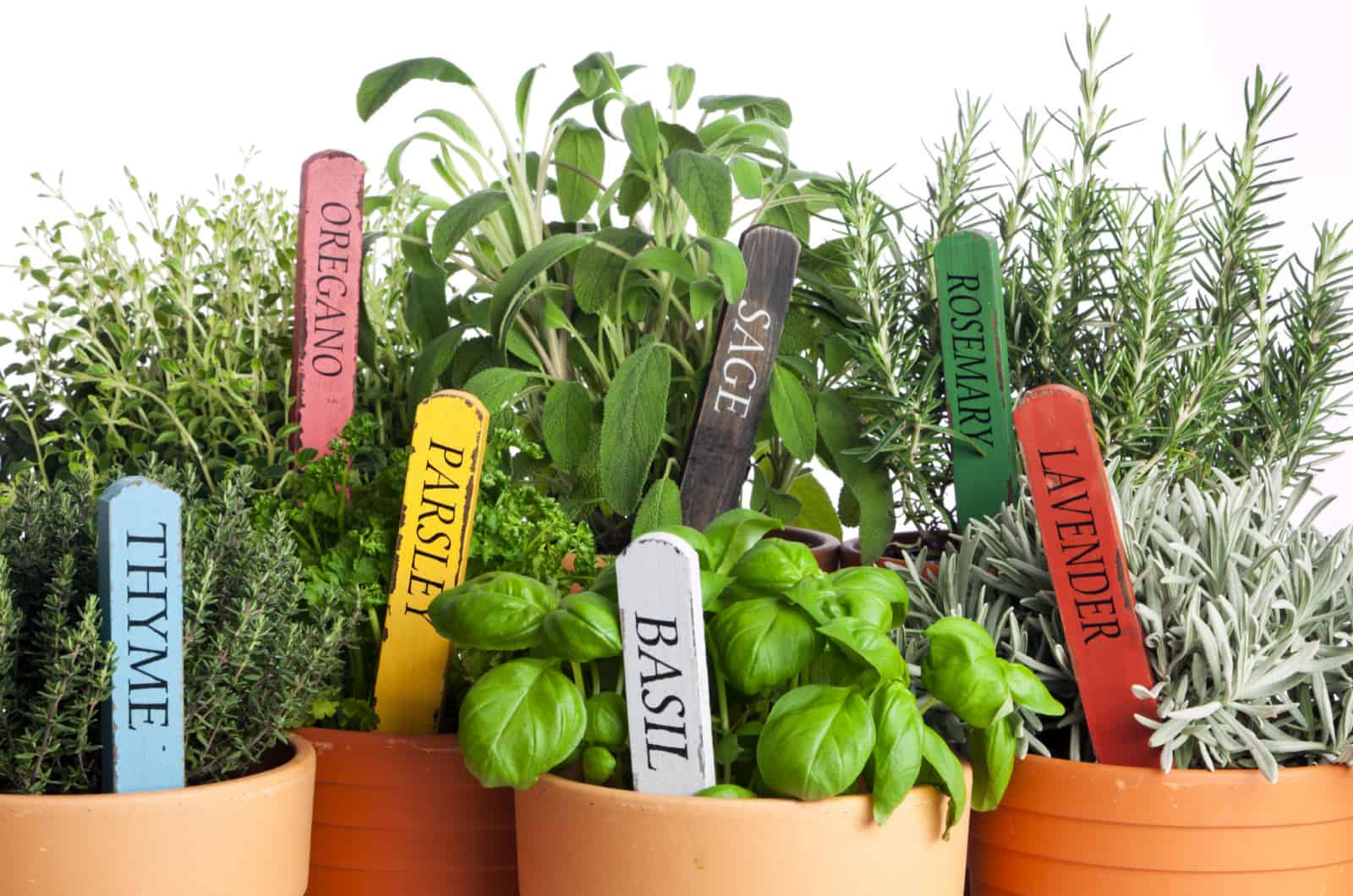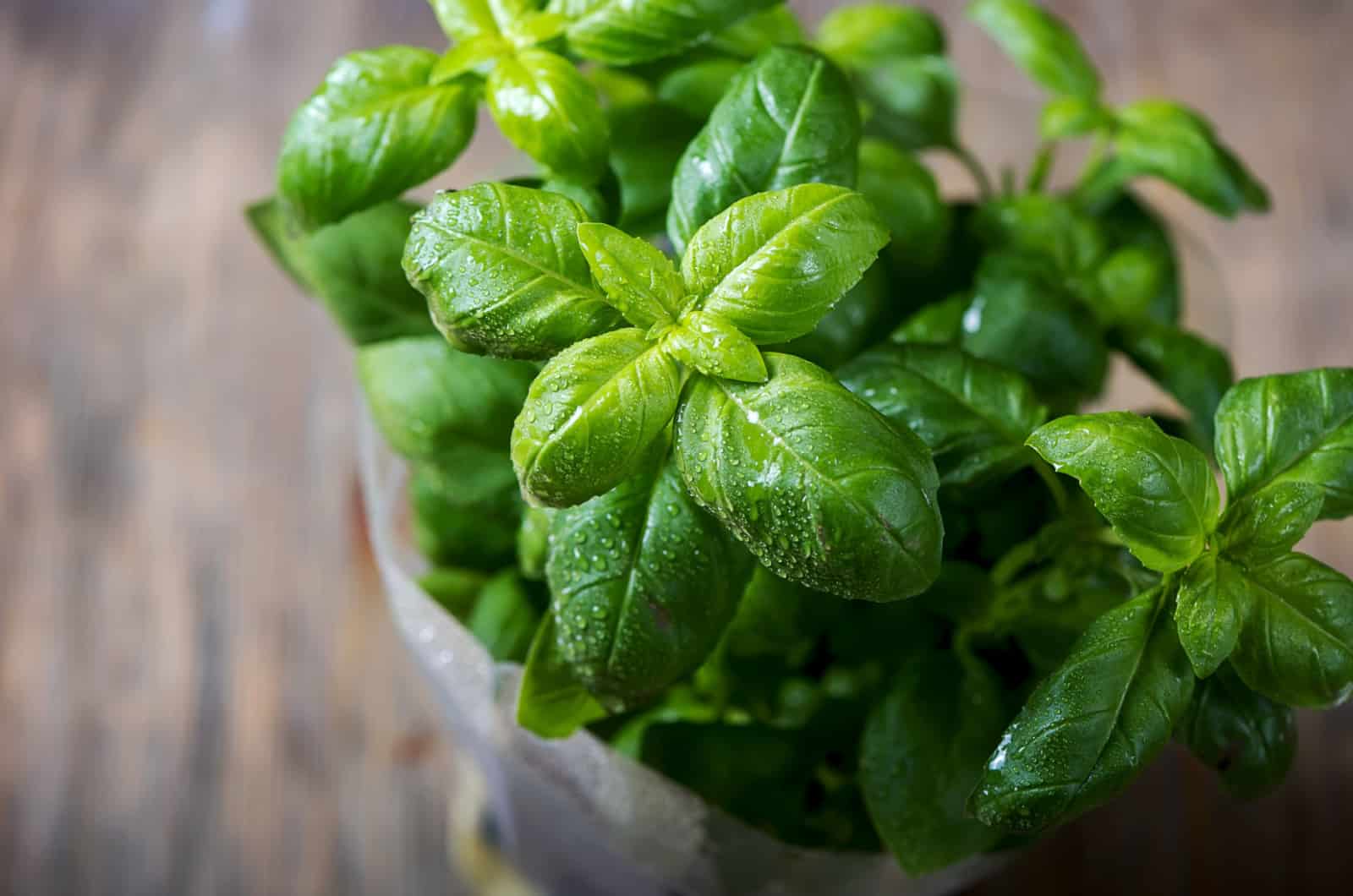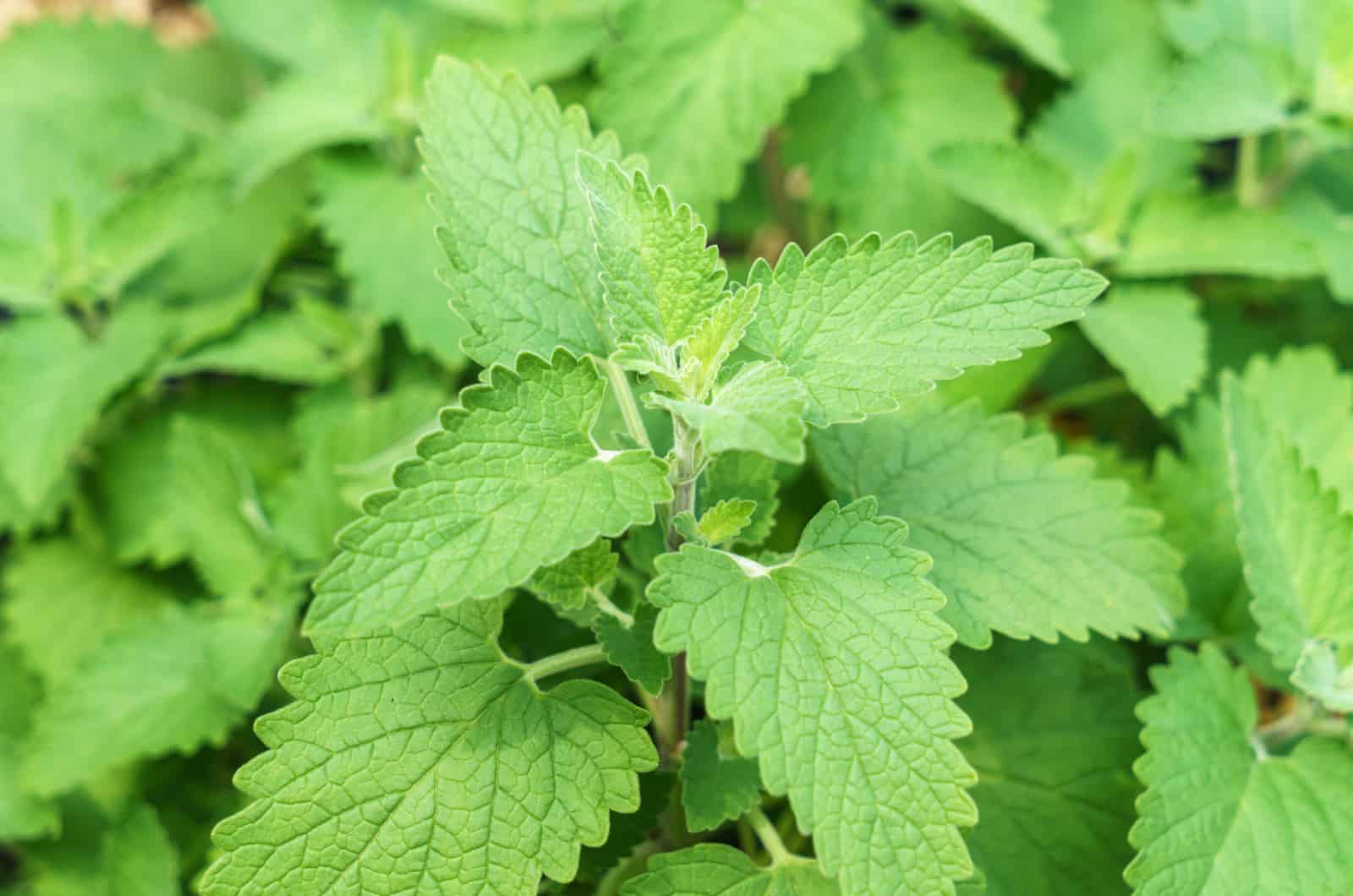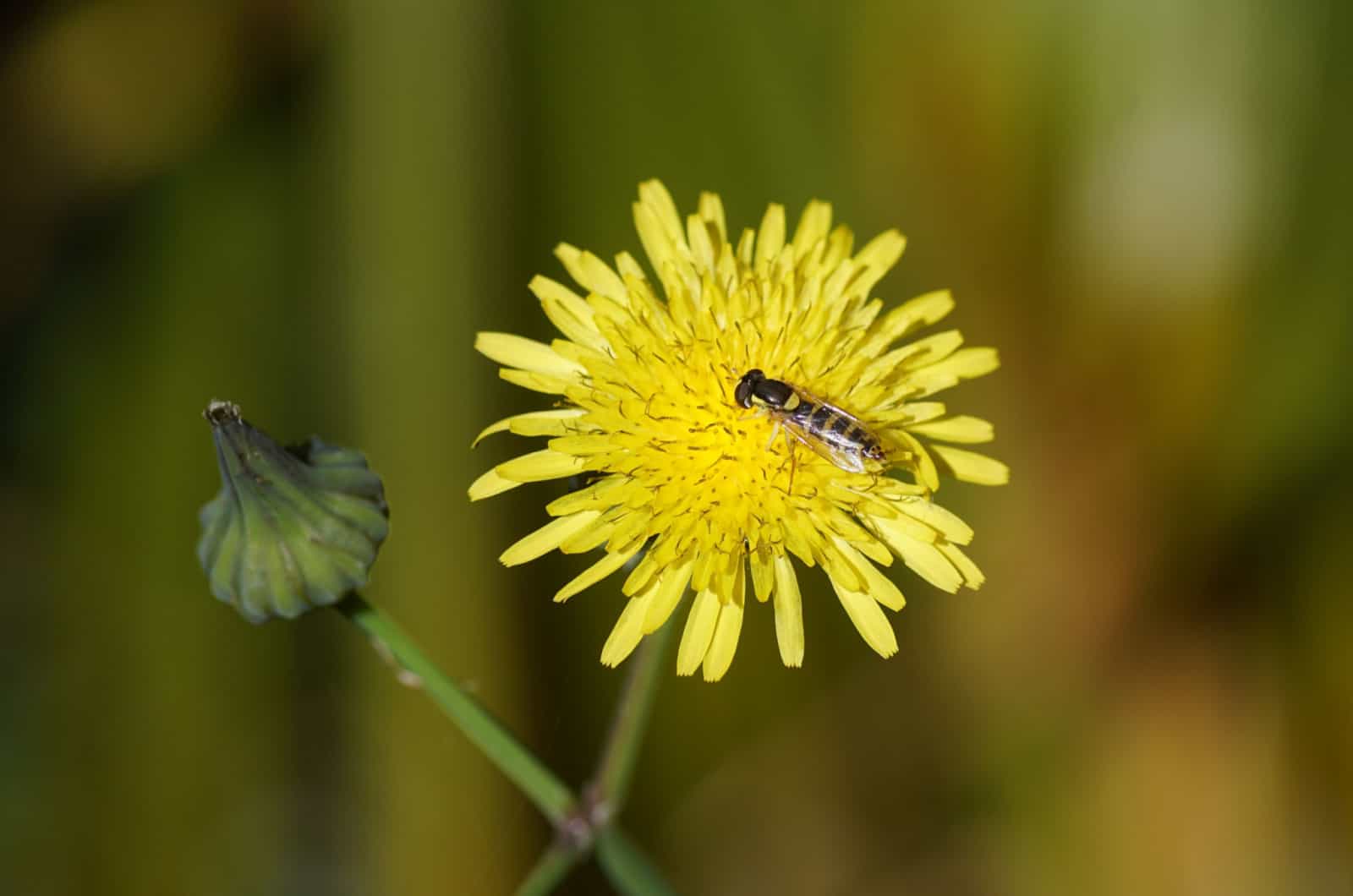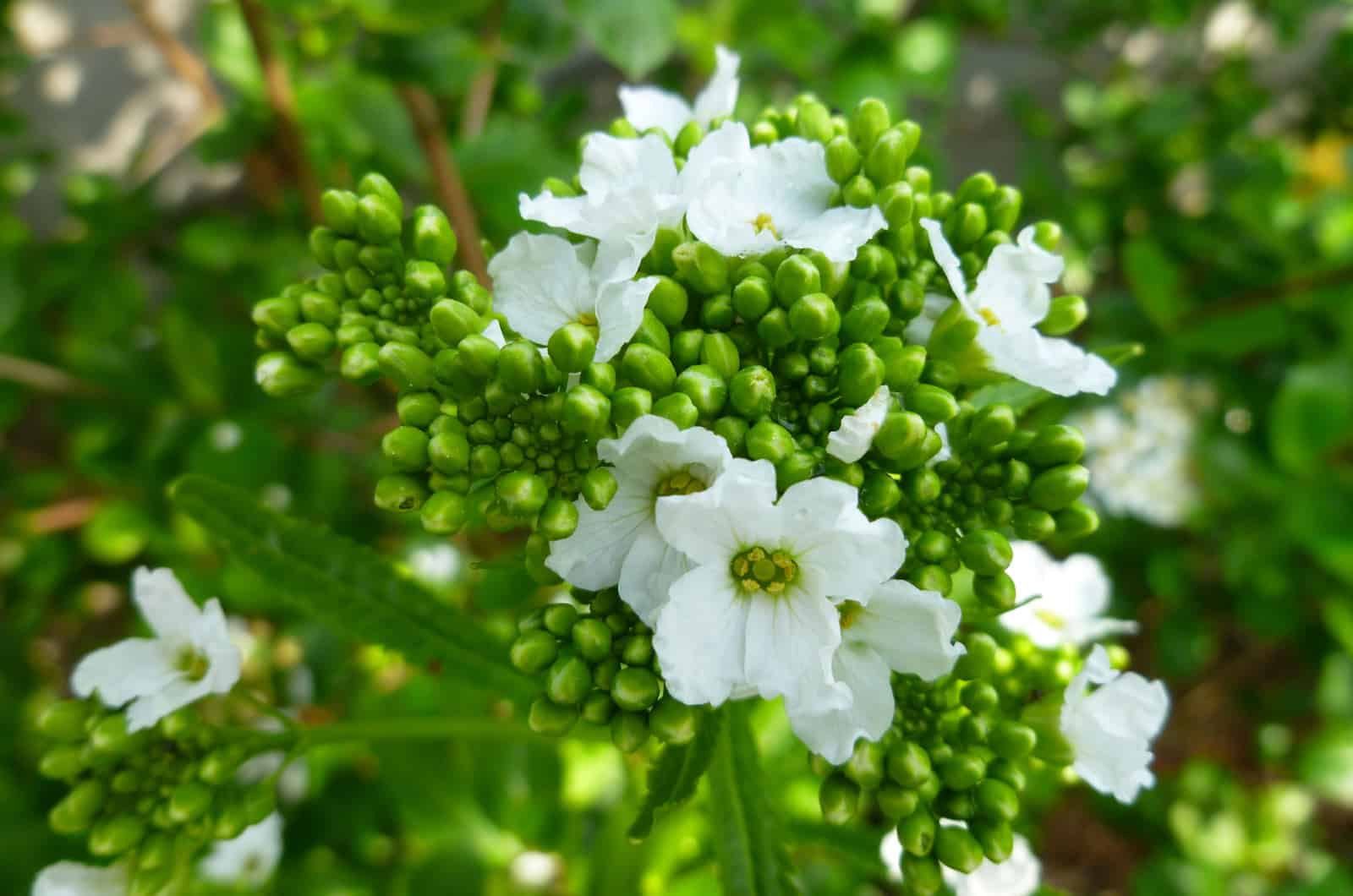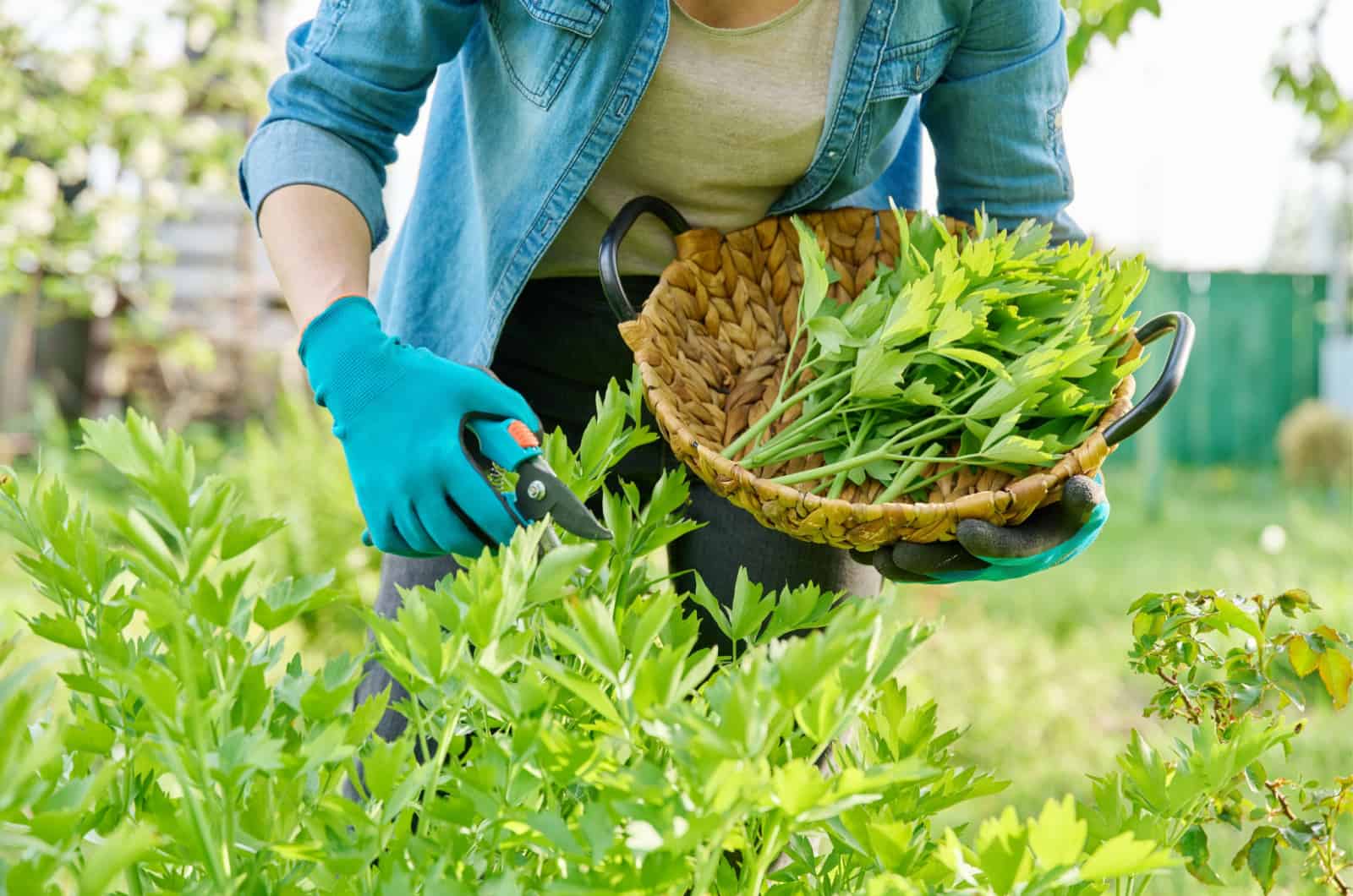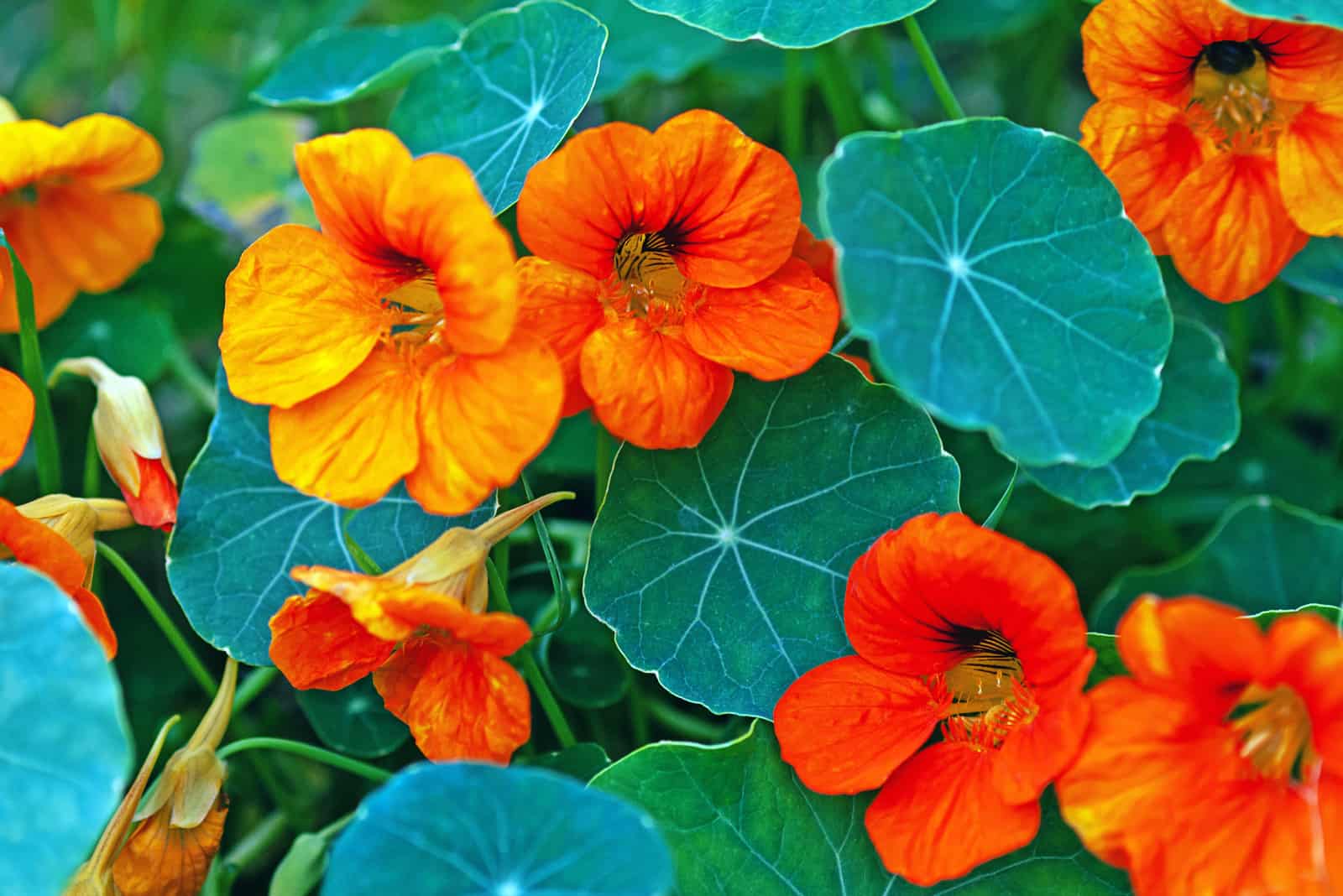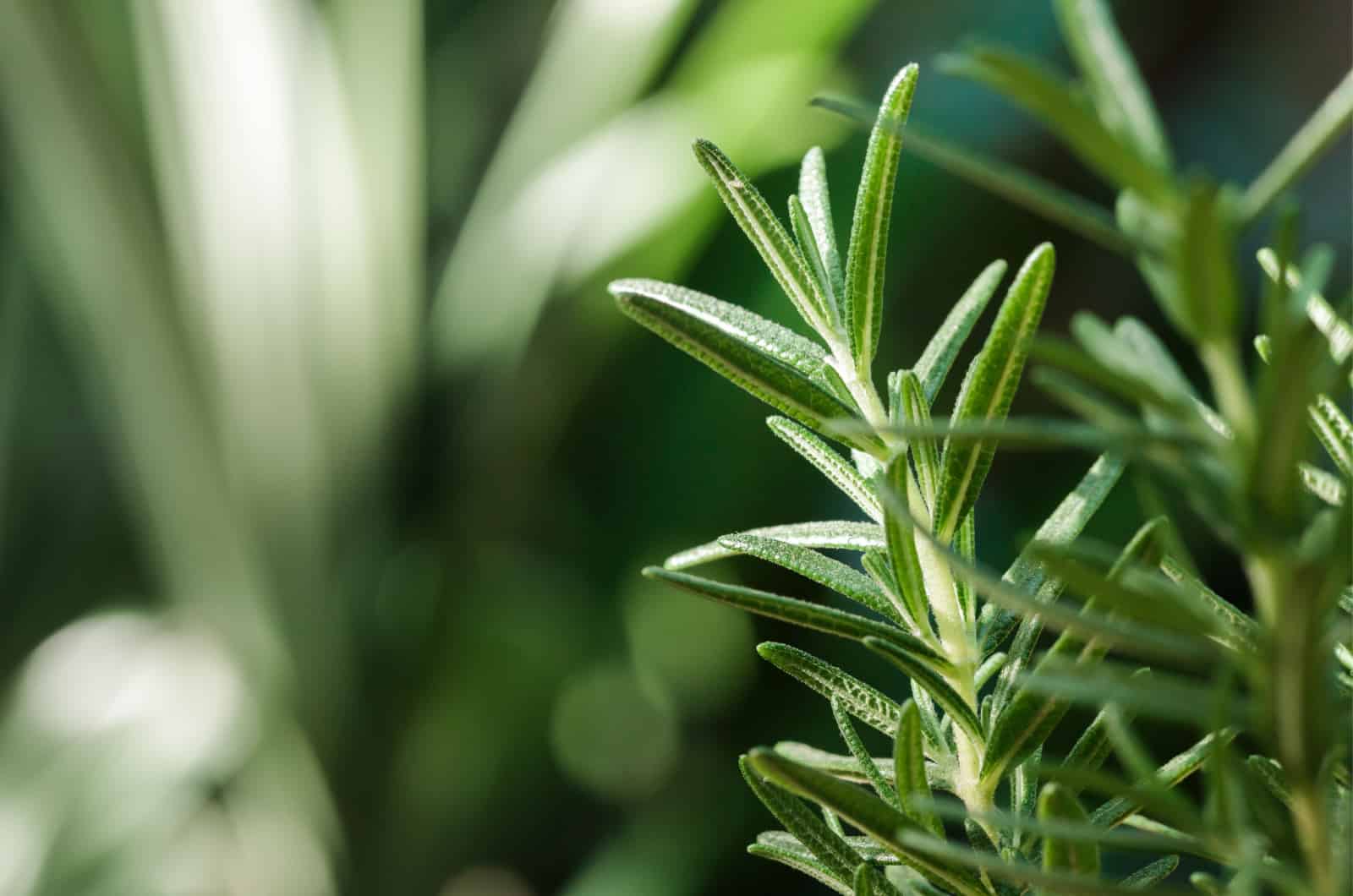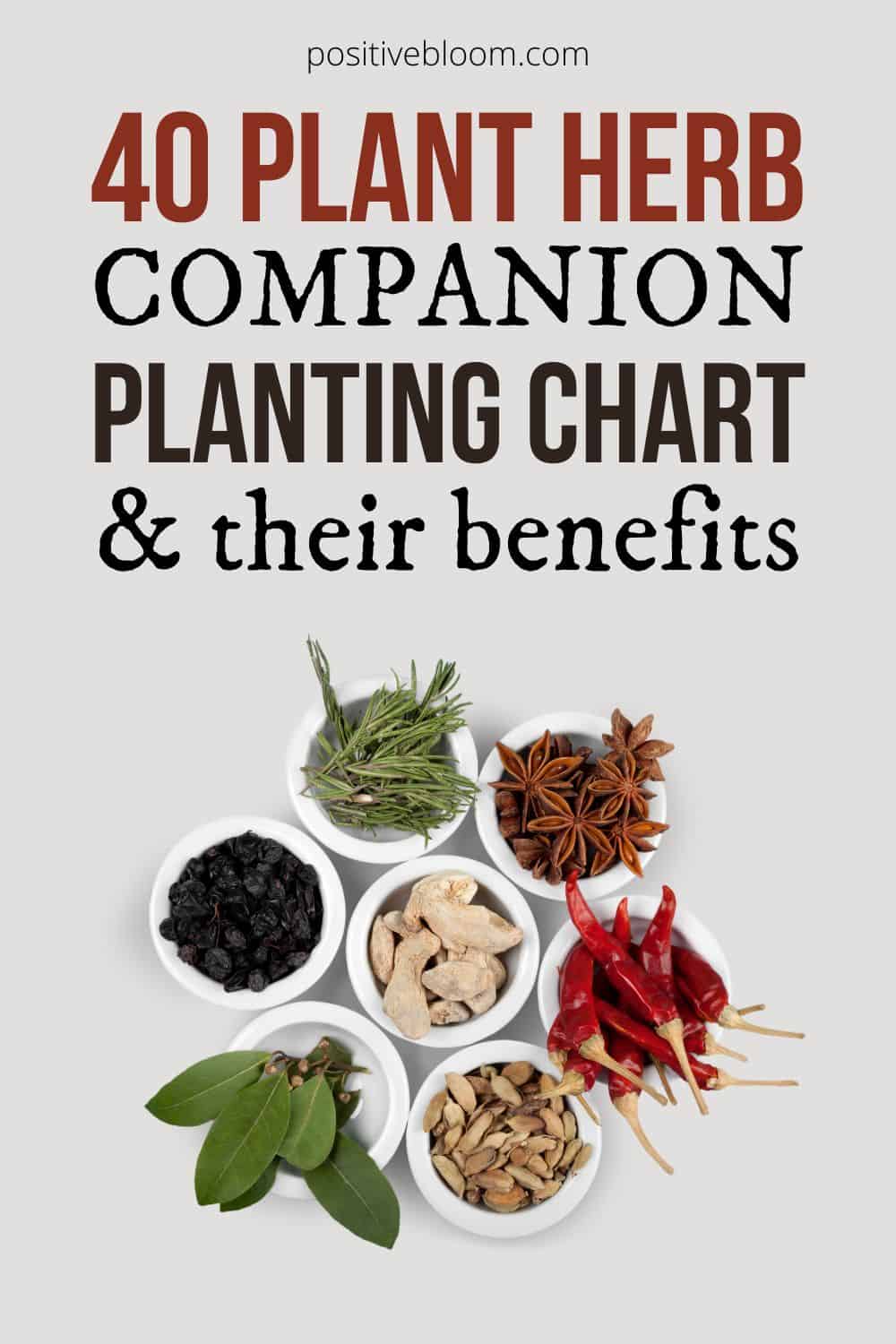Growing herbs in your own garden has many benefits, and one of them is an endless supply of rosemary and basil, the two main herbs for good pasta!
Some other benefits of having a herb garden include attracting pollinators and other beneficial insects, repelling pests, etc.
A herb companion planting chart can really help you out by letting you know which vegetables and flowers can be grown with herbs.
We put together a list of 40 popular herbs in the chart below that will help both new and experienced gardeners alike.
Let’s begin!
Herb Companion Planting Chart
Growing herbs in pots for amateurs is an excellent way to get started on this exciting journey, and companion planting can make things much simpler.
Planting herbs, vegetables, and flowers in close proximity is a great way to reduce the work you have to put into caring for your plants.
But, how do you know which plants grow well together?
Well, you basically look for herbs and vegetables (and flowers) that have similar needs.
We’ll include companion plants for 40 different herbs so that you don’t have to bash your head against the wall trying to work out whether peppers are a good friend for lavender.
1. Basil
Basil likes growing with other herbs, but if you’re more interested in veggies, you’d want to know that this fragrant plant prefers asparagus, tomatoes, peppers, chard, and all sorts of root vegetables (beets, radishes, etc.) as its companions.
Basil repels the asparagus beetle, while asparagus attracts ladybugs, a mortal enemy to aphids and other pesky insects (they’re a perfect fit, don’t you think?).
This fragrant herb can also repel mosquitoes, improve tomato yields, and make them tastier, so don’t miss out on it. However, don’t grow it with cucumbers, as basil can affect its taste.
If you notice that your basil plant is wilting, you might not be getting the best out of it, so make sure to water it regularly and keep it safe from pests and diseases.
2. Beebalm
Beebalm can be grown with squash, tomatoes, peonies, roses, etc. It is said to improve the development and flavor of its companions, so why not give it a go?
Beebalm can also attract pollinators and repel unwanted insects that may prey on your veggies and flowers.
3. Borage
Borage has become more and more famous in recent years because there’s been talk about how it can reduce the attacks of leaf-eaters such as cabbage worms and tomato hornworms.
You can grow it with many different plants, including tomatoes, strawberries, cabbage, and squash.
This herb can also improve the flavor and growth of these plants (like many other herbs), so don’t miss the opportunity to taste some delicious strawberries!
4. Caraway
Caraway is a good companion for beans, peas, and strawberries. It has many benefits; it can attract pollinators and beneficial insects, deter pests, break down and loosen the soil due to its extensive root system, and more.
This herb attracts parasitic wasps, sworn enemies to cabbage caterpillars, butterfly and moths’ eggs and larvae, etc.
Finally, you should avoid growing this herb alongside sweet fennel because cross-pollination can occur and alter the flavor.
5. Catnip
Catnip is not just for cats – your vegetable garden can also benefit from this herb. Due to its strong scent, this plant deters flea beetles, Japanese beetles, ants, aphids, cabbage loopers, etc.
You can plant it on the border of your garden to prevent these pests from entering in the first place.
Catnip attracts honeybees, but it can get quite invasive, so if you still want to reap the benefits of this herb, you can just grow it in a container and place it near the preferred companion.
Finally, you can grow catnip with collard greens, broccoli, pumpkins, potatoes, beets, etc.
6. Chamomile
We all love chamomile tea, but this plant has many other benefits you may have never even heard of. For instance, it improves the flavor and fragrance of other herbs, such as basil and mint.
It can even boost the flavor and growth of other companion plants, such as the cole crop (brussels sprouts, kohlrabi, cabbage, broccoli, etc.), roses, lilacs, dogwoods, delphiniums, onions, beans, cucumbers, and so on.
Chamomile also attracts beneficial insects such as ladybugs and hoverflies, which eat spider mites and aphids.
This plant has a strong scent, so it can deter mosquitoes. Its fragrance can also keep your carrots safe from carrot flies, but remember to plant a lot of it!
7. Chervil
This parsley-related herb will feel right at home when you grow it with radishes, cole crops, carrots, and lettuce.
It does prefer the shade, though, so pair it with shade-loving veggies!
Chervil is said to improve their taste, but we believe that the reason why so many growers pair it with cole crop is because it deters slugs.
8. Chive
Chive is a plant that goes nicely with many different vegetables, but pole beans, bush beans, and peas aren’t one of them!
If you want to find a good companion for this herb, try planting it with beets, tomatoes, carrots, eggplant, peppers, strawberries, broccoli, cabbage, kohlrabi, etc.
Chive is said to improve their taste and growth, repel certain garden pests, and attract pollinators and other helpful insects.
9. Cilantro
Cilantro is a popular herb used in many different cuisines, whether you use its leaves or dried seeds (also known as coriander), so knowing how to grow cilantro sprouts from seeds is very helpful.
However, there are also many benefits of companion planting with cilantro that you shouldn’t miss out on, as this herb can repel many different pests.
It is an excellent protector of beans, peas, tomatoes, and leafy plants as it attracts certain predatory wasps, hoverflies, and tachinid flies that eat spider mites, aphids, potato beetles, and cabbage moths.
Cilantro is even said to improve the growth intensity of certain plants, so don’t miss out on all the benefits.
10. Common Sowthistle
Even though it looks like a flower, sowthistle is actually an annual herb that is an excellent companion to corn, onions, tomatoes, cucumbers, and other veggies from the squash family.
You can use it as a trap crop as it attracts hoverflies that feed on aphids.
11. Dead Nettle
Dead nettle is an excellent companion to taller plants as it can grow well in the shade. Therefore, pair it with hydrangeas, potatoes, ferns, etc.
This plant can enhance the taste and growth speed of its companions while repelling potato beetles at the same time.
12. Dill
This aromatic herb can grow with many different vegetables, including asparagus, corn, onions, cucumbers, cole crops, etc.
It is said to enhance the development and flavor of cabbage, and can attract insects that feed on bugs that attack these plants.
However, it also attracts tomato hornworms, so it’s not a companion you’d wish for your tomatoes. You should also avoid planting it near carrots because it can stunt their growth and cross-pollinate, tainting the flavor.
13. Fennel
Not many plants can survive near fennel, and one of the few that can is dill. However, you should avoid planting this herb near your vegetables as it produces substances that inhibit germination and growth.
More research needs to be conducted on this topic because we’ve seen fennel growing near sage, oregano, chives, and similar herbs without affecting it.
It also deters aphids, so you can plant it as a border around your garden if you’re afraid it might harm your plants.
14. Flax
Unlike fennel, flax has many great companion plants that love it, and can get along nicely with potatoes and carrots.
It intensifies the growth and taste of these veggies, and it can deter potato bugs.
15. Horseradish
Plants that can get the most out of this herb are potatoes, strawberries, rhubarb, asparagus, etc.
It is an excellent form of natural pest control as it deters potato beetles and bugs, aphids, and whiteflies. Horseradish can even repel moles, birds, and mice, so you should try planting it near grapes and different berries.
16. Henbit
This herb is an excellent choice if you want to attract more pollinators, such as honeybees, and repel pesky insects.
It is an excellent companion to small grains, such as wheat, rye, barley, and oats.
17. Hyssop
Hyssop attracts many beneficial insects that keep your veggies safe from pests.
It is a good companion to grapes, cauliflower, and cabbage, but it can also get along with ornamental grasses and other herbs.
Hyssop is believed to aid grapes with their growth and repel cabbage moth, but it doesn’t grow well with radish (actually, it is the radish that doesn’t grow well as hyssop stunts its development and growth).
18. Lavender
Lavender has many benefits, but most gardeners love it because it is a natural pest repellent. It deters slugs, fleas, aphids, moths, ticks, mosquitoes, and even deer due to its strong fragrance.
It doesn’t require much care, so don’t plant it with needy plants, or you’ll soon see signs of overwatered lavender.
However, this plant is an excellent companion to cole crops, tomatoes, cucumbers, celery, chard, and many other herbs. Of course, their needs differ, but you can always plant lavender in a container.
19. Lemon Balm
Many fruits and veggies are perfect companions to lemon balm, and you can grow it near melons, tomatoes, squash, cole crops, apples, kiwi, etc.
It attracts bees and other pollinators with its citrusy scent and repels gnats and mosquitoes at the same time.
Lemon balm can be invasive, so if you don’t feel like dealing with it and limiting its growth, you can always grow it in pots.
20. Lovage
Lovage is considered to go well with any plant in your garden as it can enhance their health. We’ve seen many combinations of this herb with veggies, such as rhubarb, asparagus, potatoes, and other root vegetables.
You can even pair it with geraniums!
This culinary herb has a similar flavor to celery, and you can use it in its stead. Or you can create a trap crop with it to keep tomato hornworms away from your tomatoes.
21. Marigold
This plant deters pretty much everything, from nematodes and Mexican bean beetles to aphids, potato, Japanese, and flea beetles, and squash bugs.
It can even repel rabbits from nibbling on your other flowers!
You can pair it with flowers of similar colors or use it to keep your cucumbers, tomatoes, potatoes, beans, onions, squash, eggplants, melons, etc., safe.
22. Mint
There are many herbs in the mint family, but when we say mint, we mean peppermint and spearmint.
These two varieties aren’t the same, so they have different benefits. For instance, peppermint is excellent at repelling cabbage moths, while spearmint is usually used to fight aphids and ants.
Of course, both varieties have strong scents and can be used to deter various insects.
You can plant them with peas and beans, cole crops, tomatoes, eggplants, carrots, chard, etc. The mint will enhance the flavor of these plants and help them develop healthily.
23. Marjoram
This culinary herb is also from the mint family, so it can improve the taste of its companions and encourage their growth.
Marjoram also produces alluring blossoms that are attractive to all sorts of pollinators.
It is an excellent companion to many different herbs and vegetables, such as chard, celery, eggplant, onion, corn, radishes, peas, and potatoes.
24. Mole Plant
Just like its name suggests, this plant has something to do with moles. It prevents these small rodents (and mice) from destroying your crops if you plant it around the garden.
It grows well with lemongrass and rosemary, but other plants also seem to like it.
25. Nasturtium
There are many good companion plants for nasturtium, but they usually fall into two families: the cabbage and cucurbit family.
Therefore, you can plant nasturtium with cucumbers, melons, squash, cabbage, kale, brussels sprouts, kohlrabi, turnip, radishes, etc.
You can use it as a trap crop to lure pests, such as aphids, pumpkin beetles, squash bags, etc., away from these veggies. Simply plant it at a safe distance and wait for the pests to arrive.
You will have to sacrifice a couple of nasturtiums, but at least your cole crops will be intact.
You can also use this herb to enhance the flavor and growth of other nearby vegetables.
26. Oregano
Oregano can be grown with many different vegetables, such as turnips, kohlrabi, brussels sprouts, broccoli, cauliflower, eggplants, peppers, beans, squash, strawberry, etc.
It can repel cucumber beetles, aphids, and squash bugs, and attract pollinators at the same time.
27. Parsley
Parsley is a herb we use for everything, so it’s not surprising that gardeners are constantly looking for different ways of growing it to increase its yield.
Companion planting is one way to do it! Plant parsley near asparagus, tomatoes, carrots, corn, peppers, onions, peas, beans, cole crops, rose bushes, etc.
Asparagus benefit most from this, but other plants love parsley as well. It improves their growth and attracts beneficial insects, such as hoverflies, whose larvae successfully fight thrips, aphids, and other pests.
The one thing you should know about this herb is how to harvest parsley without killing it so that you can reap its benefits for longer. (You can take smaller batches and avoid gathering parsley in winter.)
28. Purslane
Purslane is frequently seen as a weed, but if you notice it growing among your small grains or vegetables, know that it is a sign that your soil is healthy and rich in minerals.
This herb is an excellent companion to beets, turnips, cabbage, carrot, radishes, and lettuce.
It protects the soil from erosion and can keep it cooler in extreme heat, something your lettuce and radishes can benefit from.
29. Pigweed
This plant adds nitrogen to the growing medium, so you can grow it near potatoes, carrots, radishes, onions, cucumber, beans, corn, and squash.
It will keep leaf miners away from your pepper plants and can even help control weeds.
30. Rosemary
Rosemary can repel carrot fly, cabbage moth, and some bean beetles, so plant it near cole crops, carrots, strawberries, beans, etc.
It thrives in drier and poorer soils, so you shouldn’t pair it with moisture-loving herbs, such as basil.
But if you want to grow it next to herbs, try pairing it with sage because rosemary is said to improve its aroma.
31. Rue
Rue is a great companion to raspberries, lavender, figs, onions, and roses.
It can easily repel pests, and is quite efficient against flea and Japanese beetles, flies, slugs and snails, aphids, onion maggots, and fish moths.
Just crush some of its leaves to release the fragrance.
32. Sage
Many gardeners have difficulties distinguishing between sage and lavender as they have similar needs. However, sage isn’t as fragrant as lavender, but it can still deter insects such as carrot flies, cabbage moths, and bean beetles.
It doesn’t prefer moist soils, so you should try and pair it with cucumbers. But there are other vegetables you can grow it with, such as carrots, strawberries, and cole crops (broccoli, brussels sprouts, turnips, etc.).
33. Southernwood Artemisia
Southernwood Artemisia is an excellent choice if you want a companion for your fruit or cabbage.
It can reduce pest invasions of many different insects, including cabbage moths, and boost your plants’ taste and development.
34. Summer Savory
This herb is a good companion for tomatoes, beans, onions, garlic, and melons, but you shouldn’t plant it near cucumbers.
It fights garden pests, attracts beneficial insects, and can even control weeds by hindering their germination.
35. Tansy
Tansy is a suitable companion for most crops, including plants from the cabbage family (kale, turnip, broccoli, etc.), fruits, roses, raspberries, etc.
It is an organic way of pest control because Japanese beetles, squash bugs, ants, and striped cucumber beetles detest it tremendously.
But tansy will also attract pollinators and other insects that fight garden pests.
36. Tarragon
Tarragon can grow with many different herbs, but if you want to grow it alongside some veggies, try combining it with eggplants, zucchini, carrots, squash, tomatoes, and broccoli.
It will keep the pests at bay and won’t alter the taste of your vegetables (okay, maybe it will improve it just a little bit!).
37. Thyme
This aromatic herb prevents worms from invading your plants, and you can grow it throughout your garden near strawberries and blueberries, cole crops, potatoes, tomatoes, eggplants, roses, etc.
Thyme can control the growth of weeds and will act as a ground cover and provide protection to your plants’ roots from the summer heat.
It may repel tomato hornworms and attract ladybugs, which will eat aphids in a blink of an eye!
Finally, thyme may improve the taste of certain plants (shallots, for instance), so don’t forget to plant a couple near them.
38. Valerian
Valerian loves growing with other herbs, but you can pair it with calendula and coneflower to create a lovely pollinator garden.
Its flowers attract many beneficial insects, and it can get up to 5 feet tall, so plant it with plants that prefer some shade.
39. Wormwood
Its name may not be appealing, but you might want to consider planting some wormwood around your garden, especially near carrots.
It hinders the attacks of carrot flies, aphids, spider mites, and mosquitoes. However, it is toxic, so don’t grow it too close to other plants as it may stunt their growth.
40. Yarrow
The last herb that has many companions is yarrow. This plant is said to improve the production of essential oils, so you can grow it with many different herbs.
Yarrow companion plants include many different veggies and flowers, including native grasses, coneflower, certain daisy varieties, apple trees, beans, onions, spinach, tomatoes, blueberries, cole crops, etc.
However, you should avoid planting this herb near cucurbits such as zucchini, cucumbers, squash, etc.
All in all, yarrow is a great companion as it attracts beneficial insects and repels the unwanted ones, and who doesn’t want free pest control in their garden?
Companion Planting Guide: What Herbs Can Be Planted Together?
Certain herb combos are frowned upon, but there is a wide range of varieties that grow well together and even benefit from it.
The thing you should bear in mind is to combine plants that have similar needs.
For instance, plant basil with other moisture-loving herbs such as chive, chamomile, and parsley.
Rosemary, on the other hand, loves drier soil, but you can plant it with marjoram, lavender, sage, thyme, and marigold.
Valerian prefers oregano and thyme as its companions, but it will do just fine if you plant it near catnip or dill.
Chervil also loves a companion or two in its close proximity, so pair it with cilantro for the best growth.
(Notice how many herbs love dill as their companion!)
Mint is not the best herb companion as it can get invasive, but it can co-exist with marigolds. You should avoid planting it together with basil, oregano, thyme, rosemary, lavender, etc.
To Sum Up
Using herb companion plants in your vegetable garden is an excellent way of improving the health of all your plants because herb companions can deter certain pests, attract beneficial insects, and improve the overall flavor and growth of your veggies.
This article brought you a herb companion planting chart that included 40 popular herbs, all of which would make a great addition to your garden.
We also presented some herbs that you can plant together in a container as it may be easier to use and grow them that way.
Enjoy your new companions, and until next time!
Like this post? Share or pin it for later!

